The Gamma-Ray Lens
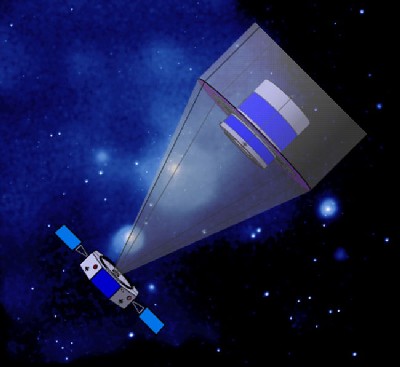 |
|
Schematic of a possible Gamma-Ray Lens. (Credit: ESA) |
Scientific Interest in Gamma-Ray Astronomy
Diagnosis of gamma-ray line emission tells astronomers a great deal about the most violent and energetic phenomena in the Universe. One particularly interesting application of a focusing gamma-ray telescope would be fine spectroscopy of the emission from Type Ia supernovae. Type Ia supernovae are an important cosmological tool as they are used as standard candles and have the potential to be used as a tool for measuring the extent of Dark Energy.
Another area of specific interest is the 511 keV emission line produced by the annihilation of electrons and positions. This distinct line is expected to be present in a range of astronomical objects including: gamma-ray bursts, accretion disks around compact objects, the galactic centre, galactic binaries, active galactic nuclei and supernovae. Annihilation radiation will reveal a great deal about the nature of these objects and, in particular, the interstellar material surrounding them.
To date the limiting problem for gamma-ray telescopes, particularly at the soft end of the spectrum at around a few hundred keV, has been instrument sensitivity and effective area. The low photon flux and high background levels at these energies result in a very low signal-to-noise ratio. The effective area of current gamma-ray instruments are, at best, equivalent to the area of the detector. As high-energy astrophysics is photon limited, increasing the detector size to improve effective area results in larger background readings and sensitivity reduction. At best, sensitivity increases as the square root of detector surface area.
A focusing gamma-ray telescope would overcome some of these problems by allowing the creation of a smaller detector plane as well as offering lower intrinsic noise levels. A 1 million second point source observation at 511 keV would return an instrument sensitivity around 100 times higher than currently obtainable with INTEGRAL.
Gamma-Ray Focussing Technologies
There are two main gamma-ray focusing technologies that were investigated with the Gamma-Ray Lens in mind - Multilayer coatings applied to Silicon Pore Optics and Laue crystal diffraction. Both of these techniques are utilised in the mission profile to combine and provide a broader science capability.
Multilayer Coatings and Silicon Pore Optics
Multilayer mirror technology is an extension of classical high-energy optics, using the principle of reflection at grazing incidences. The multilayers are, in fact, a series of coatings, or bilayers, made up of alternating materials. Many hundreds of bilayers are used in a multilayer coating, where varying the thickness of the bilayers will affect the energy response of the optic. It is expected that the maximum energy focused will increase from ~10 keV, as from classical coatings such as gold, to ~300 keV using multilayer coatings.
Silicon Micropore Optics are novel, lightweight, high-resolution optics currently being investigated for IXO, the International X-ray Observatory. They are expected to provide a much greater effective area per unit mass than previous optic technology and will, therefore, be crucial to higher energy missions where the number of photons is very limited. A multilayer coating designed for the Gamma-Ray Lens would be applied to the Silicon Micropore Optic in order to maximise the effective area at the relevant energies of interest.
Laue Crystals and the Gamma-Ray Lens
For years, X-ray diffraction has been used to establish the structure of crystals. A high-energy ray will diffract through a crystal, changing direction depending on its energy and the crystal plane it hits. The equation that governs this is known as Bragg's law. Using this equation, a 'lens' can be constructed that changes the direction of gamma rays passing through it so they converge at a point - a focus. Crystals with a large atomic density such as copper work best as X-ray and gamma-ray diffractors. The focal length of such a lens can be very long - a lens with an effective area of about 1 square meter could have a focal length of five hundred meters! This obviously implies the need for two spacecraft flying in formation: one spacecraft carrying the lens and another holding the gamma-ray detector.
The Spacecraft
To achieve optimum performance with the large focal length of ~500m two spacecraft are required. These are described below:
The Detector Spacecraft (DSC)
The detector spacecraft is summarised as follows:
- One primary payload - a SPI-INTEGRAL-style, high resolution, Germanium detector array with an advanced inorganic scintillator anticoincidence shield
- The detector is actively cooled to 80 K
- It is the smaller of the two spacecraft - approximately 1940 kg with margin
- The DSC is the more active of the two spacecraft as it performs formation flying manoeuvres
- All science data to Earth
The Optic Spacecraft (OSC)
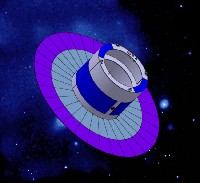 |
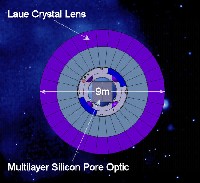 |
|
Two views of the Optic Spacecraft. (Credit: ESA) | |
The Optic spacecraft has two main payloads:
- A Multilayer Silicon Pore Optic for the 50-200 keV energy bands, and
- A Crystal Laue Lens for the 425 - 522 keV and 825 - 910 keV bands.
The OSC has the following main characteristics:
- Requires a deployment mechanism for the 9m-diameter Laue optic, which is significantly larger than the launcher fairing size
- It is the larger of the two spacecraft - approximately 3500 kg with margin
- The spacecraft is more passive than the DSC with regards to formation flying, metrology, data handling and communications
Mission Architecture
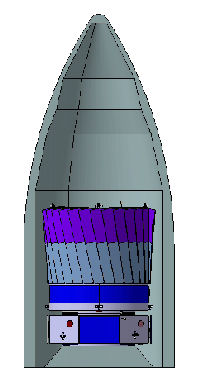
Launch configuration (Credit: ESA) |
- The two spacecraft are designed to be launched on a single dedicated Ariane 5, the spacecraft stacked with the OSC on top of the DSC.
- The spacecraft will be launched to L2, the second libration point, where formation flying can benefit from very low gravity gradients.
- The cruise phase to L2 will be performed as a stack, with the spacecraft separating and deploying after the final injection manoeuvre to L2 is made.
- At L2, the spacecraft will be in Halo orbit where very small manoeuvres will ensure zero eclipse.
- Once at L2 the two spacecraft enter observation mode, flying in rigid formation approximately 500 meters apart.
- The nominal lifetime of the spacecraft is 10 years, extendable to 15 years.
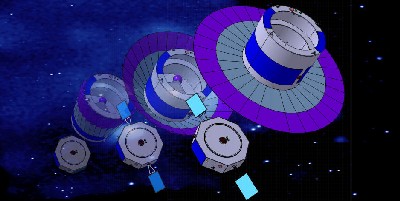 |
|
Separation and deployment of the two spacecraft (Credit: ESA) |
Challenges
Many challenges have been identified during this study, requiring either further investigation or technology development. Some key mission drivers are:
- Formation flying
- Metrology
- Laue Lens
- Gradient crystal development
- Crystal alignment
- Crystal growth and fabrication
- Deployment mechanism
- Multilayer Optics
- Multilayer design and fabrication
- Silicon Pore Optics
- Background rejection techniques
- Detector development
- Advanced inorganic scintillator detectors
Sensitivity analysis of the Gamma-Ray Lens has shown that a large improvement on previous missions is achievable - approximately one hundred times better than ESA's current gamma-ray mission, INTEGRAL.
Study details
This study has been performed by SRE-PAM with support from SRE-PAT and was completed in 2005.
Contact Information
For further information about this study please contact:
Nicola Rando
Head of Science Missions section (SRE-PAM)
Advanced Studies and Technology Preparation Division
ESA - ESTEC, Keplerlaan 1, 2201 AZ Noordwijk, The Netherlands
Nicola.Rando esa.int
esa.int
